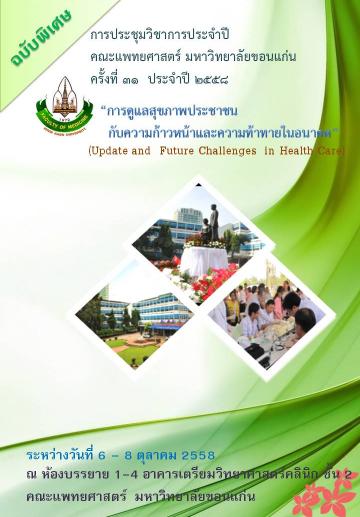Mortality and Predictive Factors in Pediatric Severe Sepsis and Septic Shock after Sepsis Bundles Implementation at Srinagarind Hospital
Keywords:
severe sepsis, septic shock, severe sepsis resuscitation bundle, Surviving Sepsis Campaign, complianceAbstract
Background: Septic shock is a major cause of death in children and associates with high mortality. Early recognition and prompt initial resuscitation of severe sepsis could improve its outcomes.
The Surviving Sepsis Campaign guidelines for the management of severe sepsis and septic shock have been recommended for improving the standard treatment in order to decrease morbidity and mortality. This has been followed by most contemporary treatment centers, especially in developed countries. However, the bundle has not been widely utilized in many developing countries due to inadequate resources in multiple levels.
Objective: To study mortality rates and associated factors in Pediatric patients with severe sepsis and septic shock treated in the Pediatric Intensive Care Unit (PICU), Department of Pediatrics, Srinagarind Hospital, Khon Kaen University (KKU) after the implementation of the survival sepsis campaign guideline.
Study design: Retrospective descriptive study
Study population : Pediatric patients aged 1 month – 15 years with sepsis and septic shock treated in the PICU, Department of Pediatrics, Srinagarind hospital, KKU from January 1st, 2013 – December 31st 2013. Exclusion criteria were dengue shock syndrome, congenital heart disease and end stage disease or palliative children.
Method: The sepsis bundle guideline for treating sepsis and septic shock was distributed to pediatric residents in the PICU. Medical record of patients treated in 2013 was reviewed. The mortality rate was compared with historical control (patients treated with sepsis and septic shock in 2012) using Chi-square, Fisher Exact test, Multivariate logistic regression.
Results: Thirty patients (13 females, 17 males ) were diagnosed with sepsis and septic shock during the study period. The median age was 8.5 years (2 months – 14.5 years). The two most common underlying diseases were hematologic malignancies (37.9%) and connective tissue disease (13%). Of note, 27.6% of patients had no previous illness. The sources of infection were respiratory tract infection(25%), infective diarrhea (25%) and bacteremia (17.8%). Positive blood cultures were documented in 42.8% of patients. The most organisms included Burkholderia pseudomallei(10.7%), MRSE (10.7%) and Pseudomonas aeruginosa (7.1%). After the implementation of the sepsis bundle guideline, the mortality rate has significantly decreased from 65.2% to 23.3% (p=0.002) compared to the previous year record. Factors significantly associated with increased mortality rates included the presence of DIC (OR 10.5, 95%CI 1.06 – 103.5, p =0.02), central venous oxygen saturation (ScvO2) <70% (OR 16.5, 95% CI 1.0 - 250.1, p= 0.02 ) and lactate level > 4 mmol/L (OR 28.3, 95% CI 2.3 - 336.0, p value <0.01) . The reduction in mortality rates could potentially be explained by prompt initial fluid resuscitation, appropriate use of antibiotics, and earlier initiation of inotropic agents.
Conclusions: The implementation of the sepsis bundle guideline appears to be feasible and leads to an improvement of treatment outcomes in a tertiary care center in a developing country. ScvO2 and lactate levels could potentially be used to predict mortality. A multicenter prospective study in a larger population could better clarify the role of the guideline implementation in developing countries.


